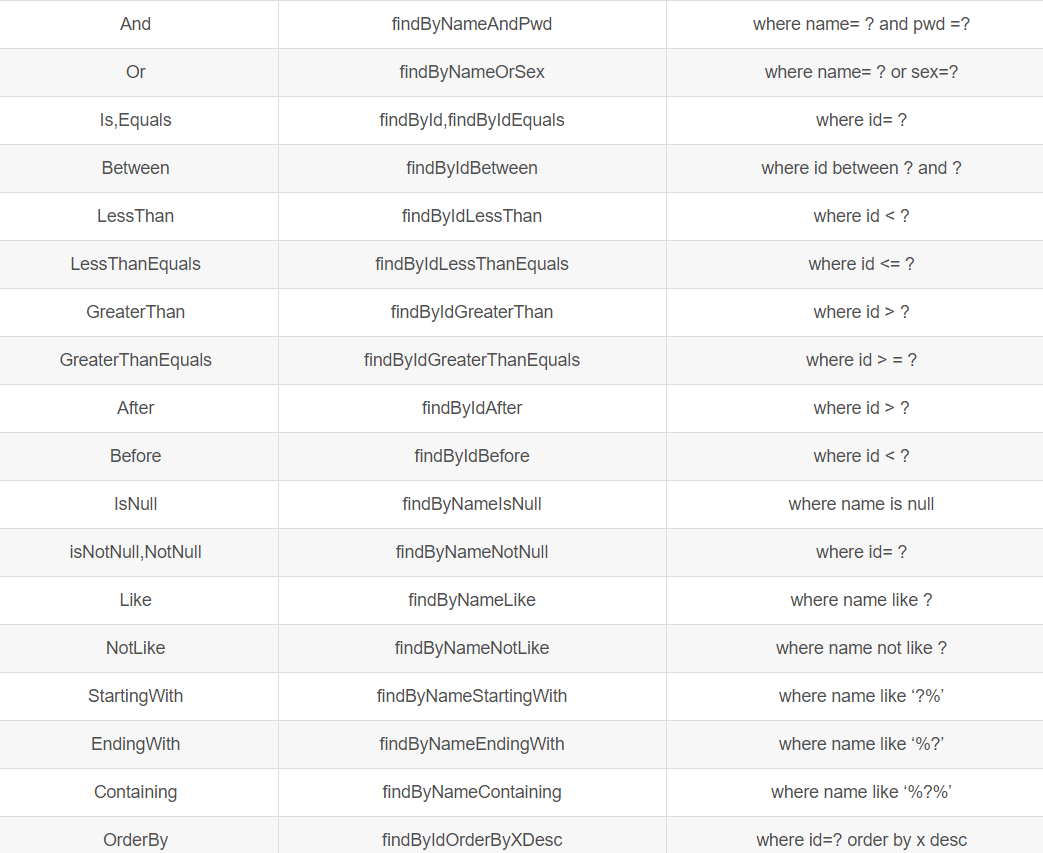@Modifying @Query("update AccountInfo a set a.salary = ?1 where a.salary < ?2") public int increaseSalary(int after, int before);
- And --- 等价于 SQL 中的 and 关键字,比如 findByUsernameAndPassword(String user, Striang pwd);
- Or --- 等价于 SQL 中的 or 关键字,比如 findByUsernameOrAddress(String user, String addr);
- Between --- 等价于 SQL 中的 between 关键字,比如 findBySalaryBetween(int max, int min);
- LessThan --- 等价于 SQL 中的 "<",比如 findBySalaryLessThan(int max);
- GreaterThan --- 等价于 SQL 中的">",比如 findBySalaryGreaterThan(int min);
- IsNull --- 等价于 SQL 中的 "is null",比如 findByUsernameIsNull();
- IsNotNull --- 等价于 SQL 中的 "is not null",比如 findByUsernameIsNotNull();
- NotNull --- 与 IsNotNull 等价;
- Like --- 等价于 SQL 中的 "like",比如 findByUsernameLike(String user);
- NotLike --- 等价于 SQL 中的 "not like",比如 findByUsernameNotLike(String user);
- OrderBy --- 等价于 SQL 中的 "order by",比如 findByUsernameOrderBySalaryAsc(String user);
- Not --- 等价于 SQL 中的 "! =",比如 findByUsernameNot(String user);
- In --- 等价于 SQL 中的 "in",比如 findByUsernameIn(Collection<String> userList) ,方法的参数可以是 Collection 类型,也可以是数组或者不定长参数;
- NotIn --- 等价于 SQL 中的 "not in",比如 findByUsernameNotIn(Collection<String> userList) ,方法的参数可以是 Collection 类型,也可以是数组或者不定长参数;


使用 @Query 创建查询
方法一:
public interface UserDao extends Repository<AccountInfo, Long> { @Query("select a from AccountInfo a where a.accountId = ?1") public AccountInfo findByAccountId(Long accountId); @Query("select a from AccountInfo a where a.balance > ?1") public Page<AccountInfo> findByBalanceGreaterThan( Integer balance,Pageable pageable); }方法二:
public interface UserDao extends Repository<AccountInfo, Long> { public AccountInfo save(AccountInfo accountInfo); @Query("from AccountInfo a where a.accountId = :id") public AccountInfo findByAccountId(@Param("id")Long accountId); @Query("from AccountInfo a where a.balance > :balance") public Page<AccountInfo> findByBalanceGreaterThan( @Param("balance")Integer balance,Pageable pageable); }开发者也可以通过使用 @Query 来执行一个更新操作,为此,我们需要在使用 @Query 的同时,用 @Modifying 来将该操作标识为修改查询,这样框架最终会生成一个更新的操作,而非查询。如下所示:
@Modifying
@Query("update AccountInfo a set a.salary = ?1 where a.salary < ?2")
public int increaseSalary(int after, int before);
创建查询的顺序
Spring Data JPA 在为接口创建代理对象时,如果发现同时存在多种上述情况可用,它该优先采用哪种策略呢?为此,<jpa:repositories> 提供了 query-lookup-strategy 属性,用以指定查找的顺序。它有如下三个取值:
- create --- 通过解析方法名字来创建查询。即使有符合的命名查询,或者方法通过 @Query 指定的查询语句,都将会被忽略。
- create-if-not-found --- 如果方法通过 @Query 指定了查询语句,则使用该语句实现查询;如果没有,则查找是否定义了符合条件的命名查询,如果找到,则使用该命名查询;如果两者都没有找到,则通过解析方法名字来创建查询。这是 query-lookup-strategy 属性的默认值。
- use-declared-query --- 如果方法通过 @Query 指定了查询语句,则使用该语句实现查询;如果没有,则查找是否定义了符合条件的命名查询,如果找到,则使用该命名查询;如果两者都没有找到,则抛出异常。



